The world's best seaplane fighter ?
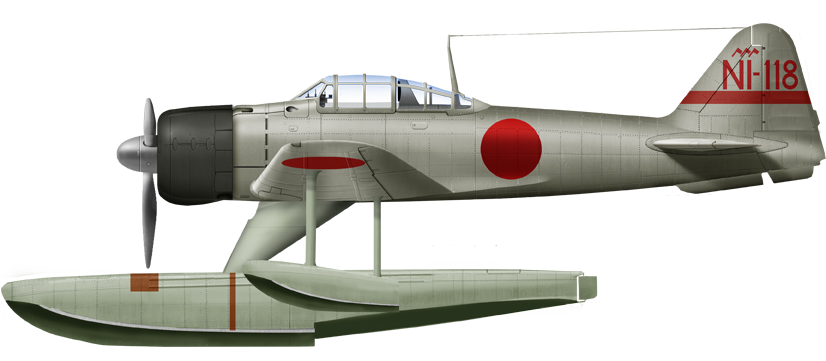
The A6M2-N floatplane was developed as requested by the Navy to support amphibious operations (operated by one of the many IJN seaplane tenders), or defend remote bases. Based on the A6M-2 Model 11 technically, it had a modified tail to keep stability with a much higher drag, cauised by the added floats: One large under the fuselage to keep balace and two small underwing. 327 total were built, a pinprick compared to the needs if global A6M production. They found their use, downed many allied aircrafts, and were still around in 1945 despite the concept being obsolete. #ww2 #IJN #imperialjapanesenavy #a6mzero #mitsubishi #nakajima #rufe
Development
The war over China, or its experience by the Navy showed it had little in the way of opposing the Chinese Air Force E7K and E8N floatplanes carried there by seaplane tenders of the IJN. The E8N gave some better performences, and was effectively to provide local air support to ground units. The F1M later was a clear improvements, but it only arrived by early 1940. So the same year was ordered a competition for new modeld by mid-1940 to support amphibious operations, defend remote bases by the IJN staff.Indeed, the vast expanses of the Pacific meant there was not always the possibility to install an airfield (too little resources, space, unsuitable ground, etc.). But a small shore base could operate a few floatplanes at any location. Thus, in the strategy to hold the planned conquered Pacific, many seaplane bases were to dot the most remote locations, by default of a large base (such as Truk), or the presence of a fleet. The Navy at this stage already had a high performance "seaplane fighter", the Mitsubishi F1M "pete", a powerful design which was agile enough to dogfight and in practice shoot down many allied bombers between the Solomons and New Guinea, used as point-defense fighter against Australian and US bombers and fighters coming from Australia.
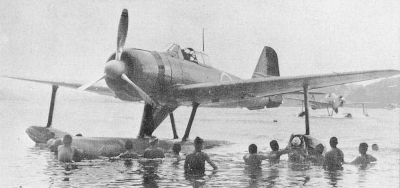 Before even it happened, experience in China showed that floatplane observation planes could actually shoot down attacking bombers and even sometimes dogfight against less capable fighters. The Navy indeed had the responsibility of shore operations in China (The army air force was tasked of the interior) and had to possess models agile enough to defend itself. The naval staff considered the F1M was never designed in teh first place as a fighter, and thus could only provided sub-par performances. What was needed was a true naval fighter, and very best on hands at the time was its A6M Zero just entering service. The closest in performances was the rival army Ki-43 "Oscar", but the Navy wanted its own.
Before even it happened, experience in China showed that floatplane observation planes could actually shoot down attacking bombers and even sometimes dogfight against less capable fighters. The Navy indeed had the responsibility of shore operations in China (The army air force was tasked of the interior) and had to possess models agile enough to defend itself. The naval staff considered the F1M was never designed in teh first place as a fighter, and thus could only provided sub-par performances. What was needed was a true naval fighter, and very best on hands at the time was its A6M Zero just entering service. The closest in performances was the rival army Ki-43 "Oscar", but the Navy wanted its own.
December 1940 really saw the first dedicated "fighting floatplane" for field forward-operating deprived of airfields or aircraft carriers and the program won priority for seaplanes. Kawanishi competed and presented soon its N1K Kyofu in a very early stage of development, which looked very promising. However the Navy enquired and soon discovered it was far from ready technically and the company was not able to deliver a ready prototype for early, nor even mid-1941, and unable to have anything on production before 1942.
Nakajima was thus selected to provide an interim solution using as a base the Mitsubishi A6M. The British Spitfire floatplane was developed for the same reasons for the FAA did not progress beyond experimental stage, and other nations also failed at producting a working concept. So Japan in the end would be the only one creating a meaningful, successful model where everyone else failed. In the end the N1K1 Kyofu 'Rex' only became operational by late 1943, so the urge for a stopgap aircraft is really what quickstarted Nakajima by February 1941 to "put on floats" the excellent Mitsubishi A6M2 Zero.
On paper, the company with its more massive manufacturing capabilities promised to turn some 900 under a year, which were the equivalent of all carrier-based kokutai possessed by Japan at the time, a seducing prospect for the top brass.
The project was thus snapped from Mitsubishi, already overburden and its production capacity full, to Nakajima that looked at its the A6M-2 Model 11 fuselage, and started to add modifications, a central float and two outer underwings one, a solution that was found the best compromise between drag and stability at sea. However it was soon apparent the drag caused anyway woould severely affect's the fighter stability, and soon the tail was modified (see later).
After all modifications were made, first tests, corrections, the prototype at last first flew on 7 December 1941 (ten months after the Navy request !), and the Navy ordered a total of 500. However Nakajima proved to be only able to deliver a total of 327, including the original prototype. The allies which met it soon added the "rufe" to their repertoire, based on the next letter in line, "R".
Design
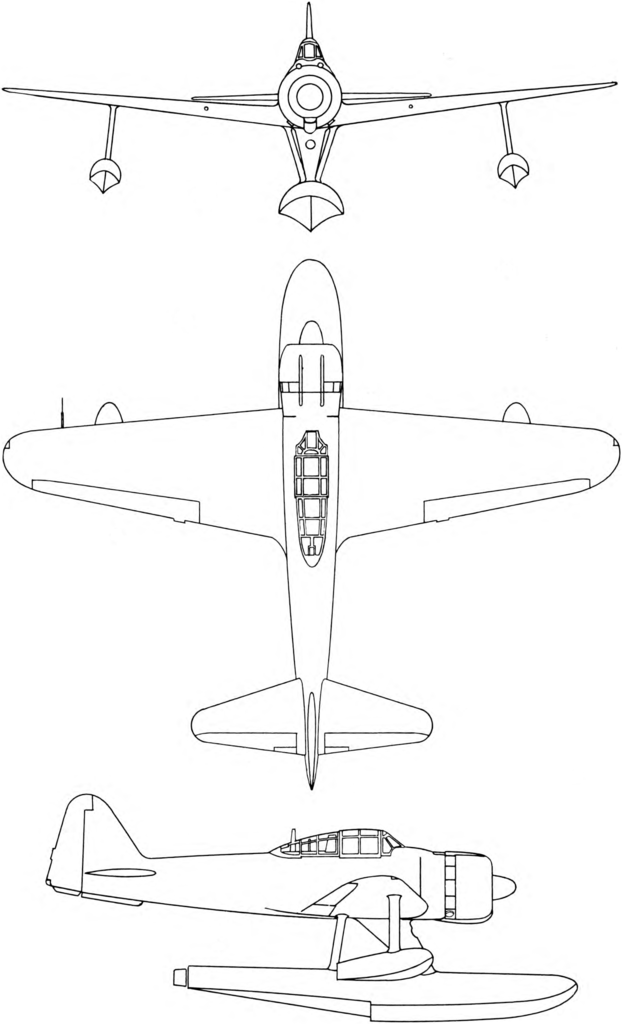
There is not much to say on the basic fuelage, wings, and details of the A6M2, they are all well detailed on the A6M article on this sub-section.
Najakima modified the retractable, wheeled undercarriage, which was completely removed and entries plated over, with a new fairing over the wheel wells. In its place, a triple-float arrangement was chosen as said above, with a large central float fixed below, so the conversion was final. It was fixed by means of a forward-raked central pylon and two V-struts below the cockpit, with steps welded to help the pilots climb in. Later some also received a small ladder. Nakajima also added two cantilever stabilizing floats mounted under the wings for additional stability on water.
The single pylon was well-worked aerodynamically in order to provide less drag, the V-strut behind being critical to avoid further tension, by spreading forces to the rear underwing/fuselage blending as well, creating essentially a tripod fixation.
The outer underwings floats were fitted with a robust single strut also attempt to reduce drag. This float arrangement would remain fixed in flight and as expected, as no change was made to the engine, the "stopgap" performances suffered. The new redesigned tail ended straight, not with a curved end tail as the original, straight rudder end, and the under fuselage section received some sort of "keel" in an attempt to counteract the float's moves. It was composed of two sections, with a smaller but deeper aft one.
The cockpit was the same, with the M2 greenhouse-style canopy providing good overall view around, and original A6M armament of two 20mm cannons and two 7.7mm machine guns was retained as well. This combination already proved effectived over China in mid-1941. The maiden flight, ironically would take plce on December 7th, 1941, and after many modifications, it was adopted by the IJN as "A6M2-N". The full armament was notified as being the same as the original in order to benefit from the proven performances of the following:
Two 7.7 mm (0.303 in) Type 97 machine guns in forward fuselage, recesses in the engine cowling, 1000 rounds. Two 20 mm (0.787 in) Type 99 Mark 1 autocannon in the outer wings, with c400 rounds And two underwings 60 kg (132 lb) bombs, to do the bare minimum as ground support.
The powerplant was the same very same in-house Nakajima NK1C Sakae 12, a 14-cylinder air-cooled radial piston engine rated for 700 kW (940 hp) at take-off; In practical combat altitude, max power could be of 950 hp (708 kW) at 4,200 m (13,780 ft) and decreased above. It was mated to a classic 3-bladed constant-speed metal propeller, both sames as the stock A6M2.
Performance were still good compared to any previous floatplane, 435 km/h (270 mph, 235 kn) at 5,000 m (16,404 ft) and 296 km/h (184 mph, 160 kn) when cruising, but paled in comparison to the A6M2 Model 21 317-332 mph (505-535 kph). It had a practical 1,148 km (713 mi, 620 nmi) range, 1,783 km (1,108 mi, 963 nmi) in ferry, one go mode at low speed, and a service ceiling of 10,000 m (33,000 ft) as well as a climb rate down to 5,000 m (16,404 ft) in 6 minutes 43 seconds, compared to 6000 m in 7 min. 27 sec. It was not bad as a floatplane interceptor...
An important note here is that in no way the naval staff specified the A6M2N was to be catapulted from any ship, so nakajima was free to design a relatively light structure. Otherwide, much reinforcements would have been needed, and this would have added weight on an already overburnened fighter for its interception work. On paper we can only wonder how it would have fared on hybrid conversions or just as part of all cruiser's own complement of on-board seaplanes for self-defence. It was not completely out of the question however as it resurfaced for seaplane tenders, which were equipped with longer, larger catapults and more progressive accelerations. They were supposed to reduce the stress on the airfraime and float.

A6M2-Ns in an anchorage in Japan 1945
Appearance

Base A6M2-N, unknown unit
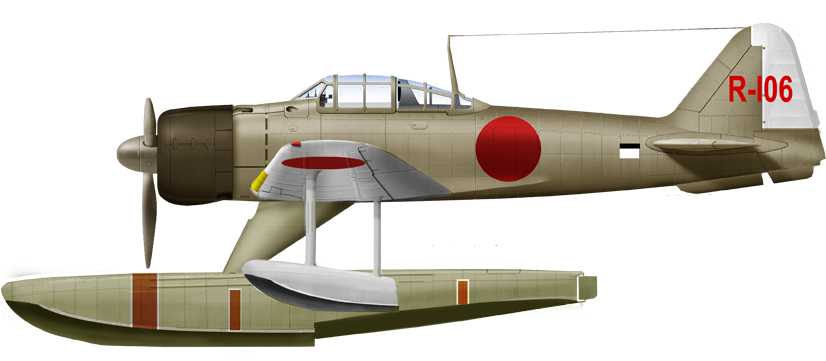
A6M2-N; 5th Kokutai, Kiska, Aleutians September 1942
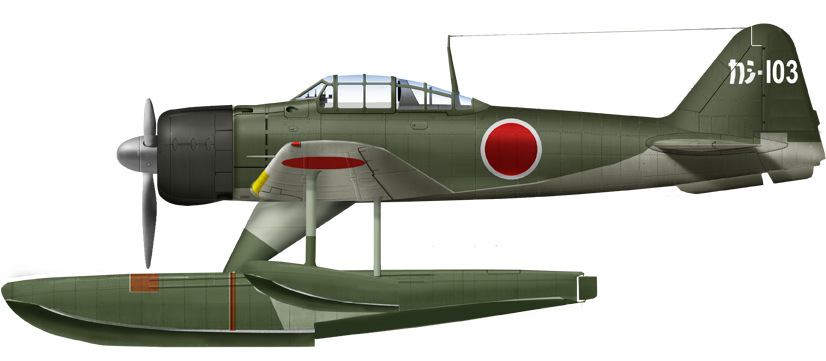
Base A6M2-N, 25th Kokutai, 5th Kantai, Kashima Naval Air Group 1943

A6M2-N serial Yo-180 Aleutians 1943-44
⚙ A6M2N Rufe specifications | |
| Empty Weight | 1,912 kg (4,215 lb) |
| Gross weight | 2,460 kg (5,423 lb) |
| Max Takeoff weight | 2,880 kg (6,349 lb) |
| Lenght | 10.1 m (33 ft 2 in) |
| Wingspan | 12 m (39 ft 4 in) |
| Height | 4.3 m (14 ft 1 in) |
| Wing Area | 22.44 m2 (241.5 sq ft) |
| Engine | Nakajima NK1C Sakae 12 14-cyl. air-cooled RP engine, 700 kW (940 hp) TO |
| Altitude max power | 950 hp (708 kW) at 4,200 m (13,780 ft) |
| Propeller | 3-bladed constant-speed metal propeller |
| Top Speed, sea level | 435 km/h (270 mph, 235 kn) at 5,000 m (16,404 ft) |
| Cruise Speed | 296 km/h (184 mph, 160 kn) |
| Range | 1,148 km (713 mi, 620 nmi) |
| Ferry Range | 1,783 km (1,108 mi, 963 nmi) |
| Climb Rate | 5,000 m (16,404 ft) in 6 minutes 43 seconds |
| Ceiling | 10,000 m (33,000 ft) |
| Armament | 2× 7.7 mm (0.303 in) Type 97, 2× 20 mm (0.787 in) Type 99 Mark 1, 2× 60 kg (132 lb) bombs |
| Crew | Pilot |
The Rufe in action

The "Otsu Air Group" used them alongside the Kawanishi N1K1 Kyofu ("Rex") from the Biwa lake, Honshū area. The French forces in Indochina managed to captured and test one of these, until crashed after being overhauled.
The "rufe" entered service in 1942 as soon as delivered, pressed into immediate action in campaigns such as the Aleutians and Solomon Islands. One A6M2-N however was captured on August 7th, 1942, after being downed by Allied fighter-bombers. It brought a number of informations on the A6M2, of which another was also soon captured. The exiting seplane fighters were put to good efficiency against less favored Allied positions. They were first issued to the Yokohama Kokutai and deployed to Tulagi in the Solomons where the Japanese had first landed during the Battle of the Coral Sea. Almost all were destroyed in a strike on the seaplane base by a flight of 15 Grumman F4Fs from USS Wasp, on 7 August 1942. The "Rufe" was deployed as the "Suisen 2" ("Hydro fighter type 2") in mostly defensive action, deployed in the Aleutians and soon also in the Solomon Islands.
The Solomons Campaign

A6M2N in the Solomons, June 1943
In the former, they were assigned to the Yokohama Kokutai based in Rabaul from June 1942. This already small unit was later dispersed to all islands without airfields of which the foremost was Tulagi on which a small makeshift depot was created. They provided protection for construction units on Guadalcanal. Several were destroyed in the August Landing. Some were detached to Rekata Bay and tried to stop Wildcats over Henderson Field. Here, no report of dogfight to compare performances. With good pilots, the "rufe" still had its chances.
The Aleutian Campaign

A6M2N at Attu Island, 15 April 1943
The Aleutian campaign proved them valuable, as the rarity of IJN platforms and rare airfields proved their usefulness in the area. They replaced land fighters of the Shumushu base in the North Kuriles, which could be diverted elsewhere. Losses started to mount when better American fighter were available. Encounters with the army P40 warhawk could have been interesting to report, but no info is available. But they earned their first kills there, a RCAF Curtiss P-40 Warhawk, a Lockheed P-38 Lightning (not a small feat !) and B-17 Flying Fortress.
These were part of the Toko Kokutai, deployed to Kiska island, and found themselves at the heart of the “Kiska Blitz”, facing daily bombing raids. On August 4th, they intercepted B-24 bombers over Kiska but made no kills. They later had occasional successes, but following recapture of Attu and Kiska, the 452 Kokutai received also the "rufe", operating from Paramushiro, Kurile Islands, and trying to defend northern islands at their range's limits.
 Recuperated wrecks at NAS Alameda, 1943 after the battle of the Aleutians
Recuperated wrecks at NAS Alameda, 1943 after the battle of the Aleutians
Dutch East Indies, Indian Ocean
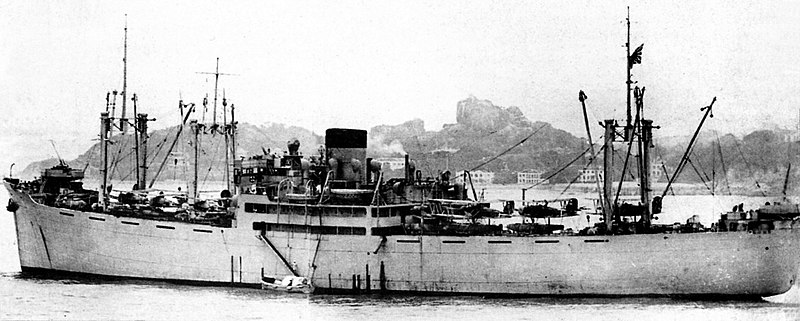 They were also used to protect vital fuel depots in Balikpapan and Avon Bases (Dutch East Indies). They were used for many missions from IJN Kamikawa Maru in the Solomons and Kuriles as well as the Hokoku Maru and Aikoku Maru in the Indian Ocean raids, but these were the only ships capable of operating these, just putting them at sea before launch (no catapults).
They were also used to protect vital fuel depots in Balikpapan and Avon Bases (Dutch East Indies). They were used for many missions from IJN Kamikawa Maru in the Solomons and Kuriles as well as the Hokoku Maru and Aikoku Maru in the Indian Ocean raids, but these were the only ships capable of operating these, just putting them at sea before launch (no catapults).
They proved versatile and were well-liked by the crews overall, performing patrols (so as observation models) even artillery spotting on occasion, escorted convoys against the USNAF, and made over-the-horizon sweeps of long range reconnaissance, an advantage of the original long-range abilities of the fighter.
The last units defending Japan
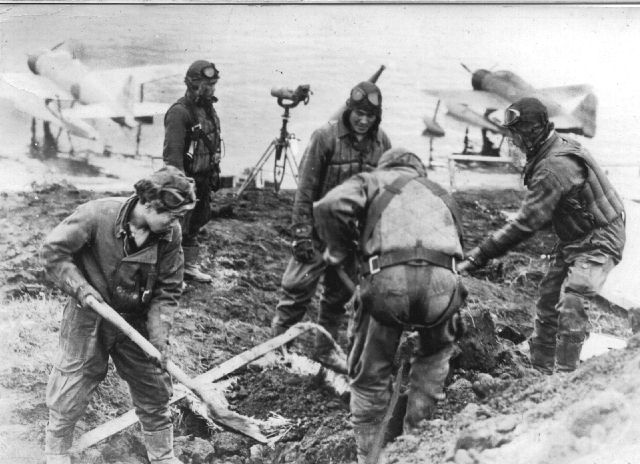
When Allied fighter coverage was fiercer, losses mounted, especially in the latter phase in 1944 and by 1944 they were based all around the Japanese homeland as an interceptors, albeit completely unable to catch high-altitude B-29. The Otsu Kokutai in particular, based on Lake Biwa, were pressed to defend Central Honshu, but suffered very heavy losses, from escorting Mustangs notably.
By late 1943 the IJN recoignised the type was no longer relevant, as meanwhile the K1N1 became the "Rex", put on wheels, the best naval fighter at this stage, whereas the 1943 floatplane was also good. This became the new standard and production of the A6M2N was halted in September 1943.
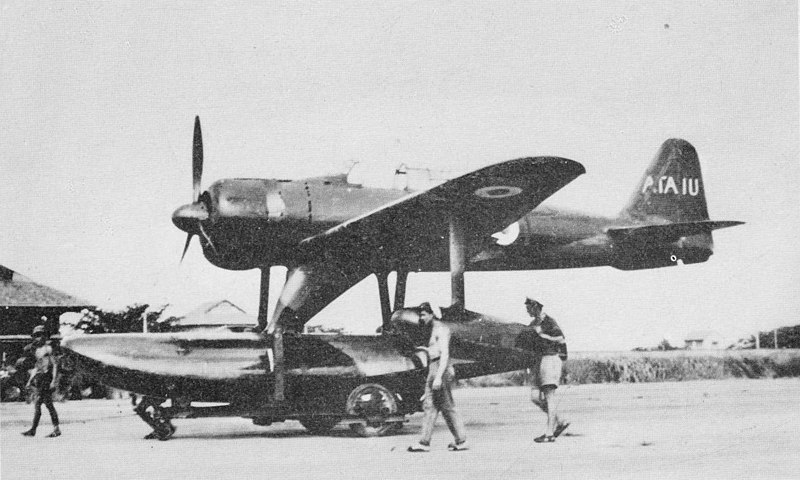
A rare A6M2N captured by the French Aeronavale in Indochina 1945-47.
read more
Books
Dorr, Robert F. and Chris Bishop. Vietnam Air War Debrief. London:Aerospace Publishing, 1996.Francillon, R.J. Japanese Aircraft of the Pacific War. London:Putnam, 1970.
Green, William. War Planes of the Second World War, Volume Six: Floatplanes. London: Macdonald & Co.
Green, William and Gordon Swanborough. The Complete Book of Fighters. New York: Smithmark, 1994.
Jackson, Robert. Combat Legend: Mitsubishi Zero. Ramsbury, Marlborough, Wiltshire, UK: Airlife Publishing, 2003.
Mikesh, Robert C. Warbird History: Zero, Combat & Development History of Japan's Legendary Mitsubishi A6M Zero Fighter.
Sakaida, Henry. Imperial Japanese Navy Aces, 1937–45. Botley, Oxford, Osprey Publishing Ltd
Gunston,Bill. The Illustrated Encyclopedia of Combat Aircraft of World War II. London, UK: Salamander Books 78
Kagero Famous Airplanes 4 Mitsubishi A6M2-N "Rufe" by Krzystof Janowicz
Links
militaryfactory.comaviastar.org/
on pacificeagles.net/
on en.wikipedia.org
- Lohner E (1913)
- Macchi M3 (1916)
- Macchi M5 (1918)
- Ansaldo ISVA (1918)
- Sopwith Baby (1916)
- Short 184 (1916)
- Fairey Campania (1917)
- Sopwith Cuckoo (1917)
- Felixstowe F.2 (1917)
- Friedrichshafen FF 33 (1916)
- Albatros W4 (1916)
- Albatros W8 (1918)
- Hanriot HD.2
- Grigorovitch M5
- IJN Farman MF.7
- IJN Yokosho Type Mo
- Yokosho Rogou Kougata (1917)
- Yokosuka Igo-Ko (1920)
- Curtiss N9 (1916)
- Aeromarine 39
- Vought VE-7
- Douglas DT (1921)
- Boeing FB.5 (1923)
- Boeing F4B (1928)
- Vought O2U/O3U Corsair (1928)
- Blackburn Blackburn (1922)
- Supermarine Seagull (1922)
- Blackburn Ripon (1926)
- Fairey IIIF (1927)
- Fairey Seal (1930)
- LGL-32 C.1 (1927)
- Caspar U1 (1921)
- Dornier Do J Wal (1922)
- Rohrbach R-III (1924)
- Mitsubishi 1MF (1923)
- Mitsubishi B1M (1923)
- Yokosuka E1Y (1923)
- Nakajima A1N (1927)
- Nakajima E2N (1927)
- Mitsubishi B2M (1927)
- Nakajima A4N (1929)
- CANT 18
WW1
✠ K.u.K. Seefliegerkorps:
 Italian Naval Aviation
Italian Naval Aviation
 RNAS
RNAS
 Marineflieger
Marineflieger
 French Naval Aviation
French Naval Aviation
 Russian Naval Aviation
Russian Naval Aviation
 IJN Air Service
IJN Air Service
 USA
USA
Interwar
 Interwar US
Interwar US
 Interwar Britain
Interwar Britain
 Interwar France
Interwar France
 Interwar Germany
Interwar Germany
 Interwar Japan
Interwar Japan
 Interwar Italy
Interwar Italy
- Curtiss SOC seagull (1934)
- Grumman FF (1931)
- Curtiss F11C Goshawk (1932)
- Grumman F2F (1933)
- Grumman F3F (1935)
- Northrop BT-1 (1935)
- Grumman J2F Duck (1936)
- Consolidated PBY Catalina (1935)
- Brewster/NAF SBN-1 (1936)
- Curtiss SBC Helldiver (1936)
- Vought SB2U Vindicator (1936)
- Brewster F2A Buffalo (1937)
- Douglas TBD Devastator (1937)
- Vought Kingfisher (1938)
- Curtiss SO3C Seamew (1939)
- Douglas SBD Dauntless (1939)
- Grumman F4F Wildcat (1940)
- F4U Corsair (NE) (1940)
- Brewster SB2A Buccaneer (1941)
- Grumman TBF/TBM Avenger (1941)
- Consolidated TBY Sea Wolf (1941)
- Grumman F6F Hellcat (1942)
- Curtiss SB2C Helldiver (1942)
- Curtiss SC Seahawk (1944)
- Grumman F8F Bearcat (1944)
- Ryan FR-1 Fireball (1944)
- Douglas AD-1 Skyraider (1945)
Fleet Air Arm
- Fairey Swordfish (1934)
- Blackburn Shark (1934)
- Supermarine Walrus (1936)
- Fairey Seafox (1936)
- Blackburn Skua (1937)
- Short Sunderland (1937)
- Blackburn Roc (1938)
- Fairey Albacore (1940)
- Fairey Fulmar (1940)
- Grumman Martlet (1941)
- Hawker sea Hurricane (1941)
- Brewster Bermuda (1942)
- Fairey Barracuda (1943)
- Fairey Firefly (1943)
- Grumman Tarpon (1943)
- Grumman Gannet (1943)
- Supermarine seafire (1943)
- Blackburn Firebrand (1944)
- Hawker Sea Fury (1944)
IJN aviation
- Aichi D1A "Susie" (1934)
- Mitsubishi A5M "Claude" (1935)
- Nakajima A4N (1935)
- Yokosuka B4Y "Jean" (1935)
- Mitsubishi G3M "Nell" (1935)
- Nakajima E8N "Dave" (1935)
- Kawanishi E7K "Alf" (1935)
- Nakajima B5N "Kate" (1937)
- Kawanishi H6K "Mavis" (1938)
- Aichi D3A "Val" (1940)
- Mitsubishi A6M "zeke" (1940)
- Nakajima E14Y "Glen" (1941)
- Nakajima B6N "Jill" (1941)
- Mitsubishi F1M "pete" (1941)
- Aichi E13A Reisu "Jake" (1941)
- Kawanishi E15K Shiun "Norm" (1941)
- Nakajima C6N Saiun "Myrt" (1942)
- Yokosuka D4Y "Judy" (1942)
- Kyushu Q1W Tokai "Lorna" (1944)
Luftwaffe
- Arado 196 (1937)
- Me109 T (1938)
- Blohm & Voss 138 Seedrache (1940)
Italian Aviation
- Savoia-Marchetti S.55
- IMAM Ro.43/44
- CANT Z.501 Gabbiano
- CANT Z.506 Airone
- CANT Z.508
- CANT Z.511
French Aeronavale
- GL.300 (1926-39)
- Levasseur PL.5 (1927)
- Potez 452 (1935)
- Loire 210 (1936)
- Loire 130 (1937)
- LN 401 (1938)
Soviet Naval Aviation
- Shavrov SH-2 (1928)
- Tupolev TB-1P (1931)
- Beriev MBR-2 (1930)
- Tupolev MR-6 (1933)
- Tupolev MTB-1 (1934)
- Beriev Be-2 (1936)
- Polikarpov I16 naval (1936)
- Tupolev MTB-2 (1937)
- Ilyushine DB-3T/TP (1937)
- Beriev Be-4 (1940)
-
Skoda Š-328V
R-XIII Idro
Fokker C.XI W (1934)
WW2
- De Havilland Sea Vixen
- Hawker Sea Hawk
- Supermarine Scimitar
- Blackburn Buccaneer
- Hawker Sea Harrier
- Douglas A4 Skyhawk
- Grumman F9F Panther
- Vought F8 Crusader
- McDonnell-Douglas F-4 Phantom-II
- North Am. A5 Vigilante
- TU-142
- Yak 38 forger
☢ Cold War
✧ NATO
 Fleet Air Arm
Fleet Air Arm
 US Navy
US Navy
☭ Warsaw Pact
Merch

Seafire Mark 45; HMS Pretoria Castle

Zeros vs its aversaries

Aichi D3A “Val” Junyo

Mitsubishi A5M poster

F4F wildcat

Macchi M5

SBD Dauntless Coral Sea

SBD Dauntless USS Enterprise

SBD-4 CV22